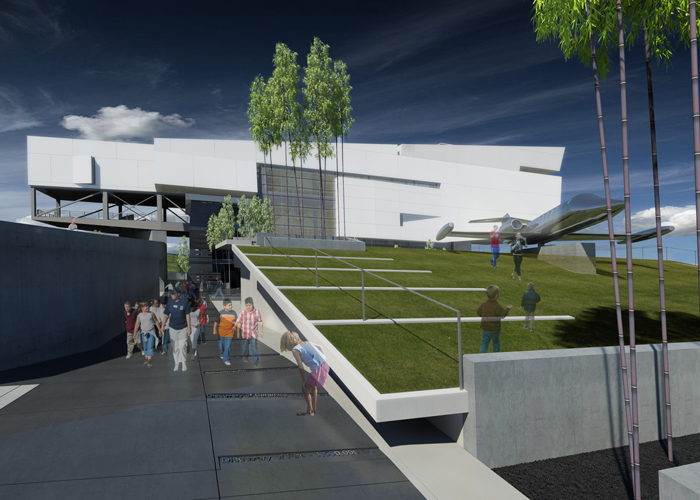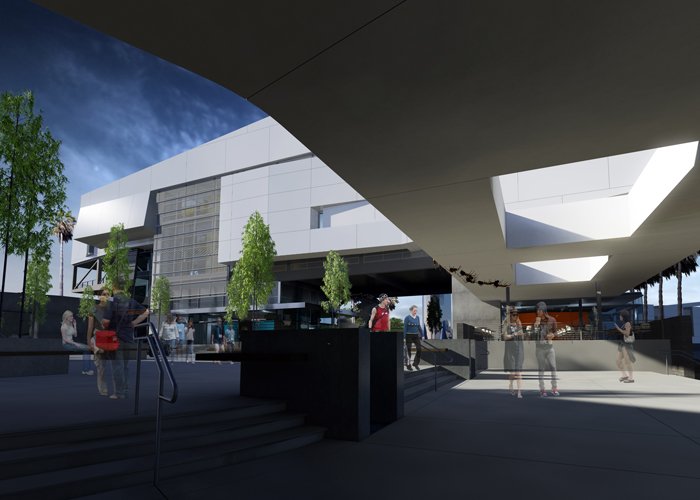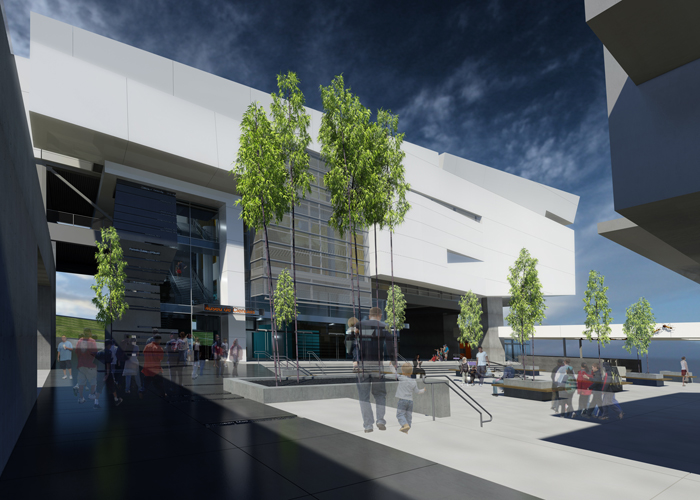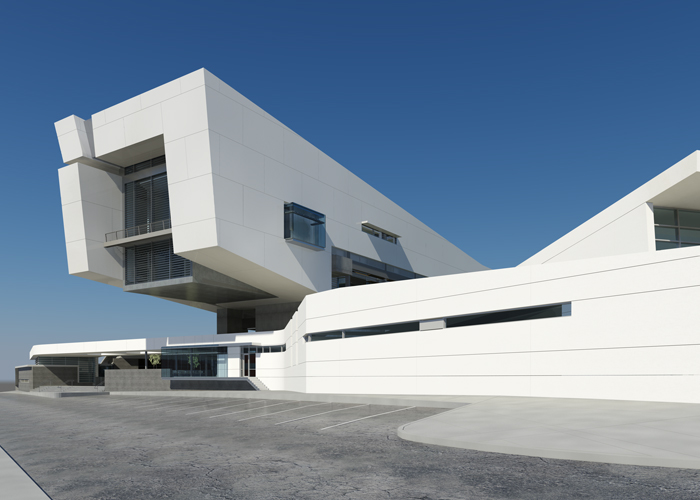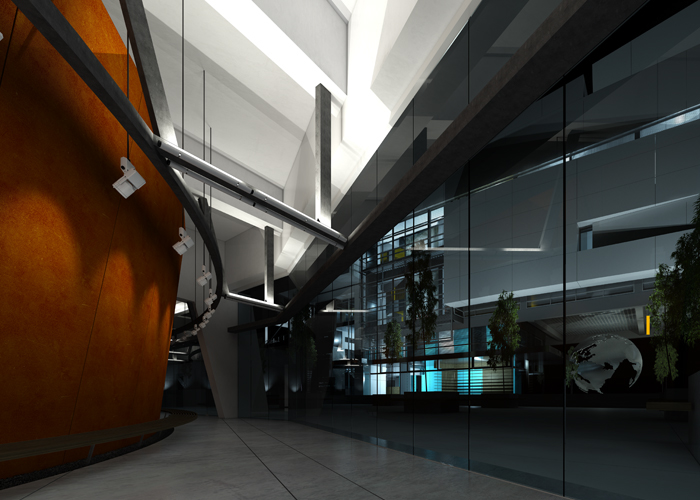
EXPLORATORY SCIENCE MUSEUM OF UNICAMP
Campinas, Brazil
Campinas, Brazil
Science and technology have hada fundamental impact on the development of the world’s societies and culturesand will play a central role in determining the nature and quality of ourfuture. These disciplines are fluid,dynamic and almost limitless in their potential to shift the trajectory of ourevolution as a species and that of the entire planet. This project aspires tocommunicate the essence of science and technology and to reveal their affect onthe world. It also demonstrates thedynamic potential for science and technology to foster a more holistic andinterconnected view of our future, one that achieves a sense of balance betweenscience and the natural world, between innovation and sustainability. Amongst the many trajectories ofmovement through the site, there are two main paths that roughly correspondwith the north-south and east-west axes. Thepath begins at the southern edge of the site, which is the main entrance fromthe parking lot and bus drop-off, at existing grade level, and slowly descendsalong with the existing topography. Along the east edge of the path, a grass plane rises gently to create amirror of the paths descent. At a pointalong the path that relates to the eye level of each observer, there is atransition from being above ground to being below ground, which signifies abasic change in man’s attitude about how he related to the natural world. With the advent of scientific knowledge andthe technological advances that resulted from this knowledge, man’srelationship with the natural world changed from living as one of many speciesthat were at the mercy of nature, to the dominant species with the ability tomold and transform nature to his will. This condition of nature harnessed for man’s use reaches its zenith inthe museum forecourt, where nature exists as a grid of trees that are containedin planters and provide shade for benches.
Throughout history, humanity has perceived science,technology and nature as distinct entities with often opposing concerns andgoals. In recent times, science andtechnology have been defined quite literally as tools for harnessing andcontrolling nature, leading to an understanding of the natural environment as aresource to be mobilized in the pursuit of realizing man’s full potential. This world view has led to great breakthroughs andunimaginable accomplishments. But it hasalso resulted in increasing social stress and ecological imbalance. No longer is there a human culture unaffectedby this flawed world view. This design proposal for the MuseuExploratorio de Ciencias fosters a paradigm shift. It instigates a new world view that focuseson an integrated and holistic understanding of the concepts of science,technology and nature. The project seeksto present science and technology as fluid, dynamic andalmost limitless in their potential to shift the trajectory of our evolution asa species and that of the entire planet, thereby bringing science, technologyand the natural world back into a state of balance. This condition of balance is concretized inthe project through the forces of inclusivity, interaction and exchange, all ofwhich give rise to a design that promotes connections between science,technology, people and the natural world. This notion of interconnectedness can be seen in a diagram ofthe relationships between scientific disciplines, which reveals a complex and highly interdisciplinary organization, both in termsof geographical relationships and exchanges between subsets of scientificinquiry. It codifies a dynamic space ofexchange, interaction and interface, out of which emerges amazing discoveriesand advances in human knowledge and industry. This notion of a rich web of intersecting movements and trajectories ofinvestigation and discovery serves as the foundation of our design strategy forthe Museu Exploratorio de Ciencias.
Weproposed to create a dynamic fabric of spaces that promote interaction anddiscovery and provide an analog to the methodological process of scientificinquiry. To capture the interdisciplinarynature of scientific inquiry, we have resisted the traditional process ofcreating a project that springs from one hierarchical concept or strategy. Rather, we have developed a series of equallystrong concepts, any one of which could inform a building design on its own,and deployed them in a manner that creates a weave of experiences throughoutthe site. This strategy of creatingconceptual and experiential richness avoids the imposition of a singularconcept by engendering a sense of exploration and discovery in visitors andstaff alike. The design engages the intellect and senses, and challenges peoplein a manner that promotes each individual to develop their own definition ofmeaning and place. This project acknowledges that theworld, and science in particular, no longer revolves around a singular anddominant theory, practice or institution, and that architecture should reflectthis richness and de-centralization by articulating heterogeneous places thatallow for interpretation and discovery. Understanding science and technology,as well as architecture, as disciplines that don’t exist in isolation butrather as activities that affect and are affected by myriad other movementsestablishes the foundation for creating a project that is inclusive and open asopposed to being repressive and closed to the richness and complexity inherentin the world.
To achieve the goal ofspatial and architectural inclusivity and richness, we have employed fourconceptual design strategies in the development of this project.
1. Building as ExtendedLandscape – The traditional distinction between building and landscape has beendismantled to create a system of fluid spaces that exist in an extendedlandscape where inside and outside merge into a system of interconnected spacesand experiences. We have folded the building program into a set of exteriorpublic spaces to allow the project to resist being contained in a singlearchitectural volume that reinforces its distinct position within the site. As such, the programmatic components are notimagined as parts of a single building, but rather as elements of a fluidspatial system that fluctuates between a quasi-urban and quasi-garden environment.The public spaces that fill out the extended landscape serve as mortar bybinding the programmatic events. This reinforcesthe significance of the public role of this project, and highlights theconnections between inside and outside, landscape and architecture, nature andman, all of which demonstrate the interdisciplinary nature of scientificinquiry.
2. Timeline of Science& Technology - The entry threshold for the site is marked by the beginningof a timeline of science and technology that draws visitors through thelandscape and into the building. Thetimeline documents key moments in the evolution of technology and the scienceswith text imbedded in the ground plane and building. The path begins level with grade and proceedsto carve into the ground, creating an increasingly significant impact on theearth. The timeline reaches a moment of extreme intensity as it passes throughthe main courtyard and delaminates from the ground plane pushing verticallyinto the mass of the museum. Thisvertical thrust corresponds with the scientific revolution on the timeline, andit marks the entrance into the museum proper, including the lobby, informationarea, store, library and a monumental stair. The timeline is a key element that is experienced partially in thelandscape spaces and in the interior of the museum as well, serving to enhance linkagebetween the interior and exterior spaces. The goal of the timeline is to educate visitors while solidifying therelationship between the spatial and pedagogical experiences, thus creating anevent that is both intellectually and physically stimulating.
3. Bridge – museum asmetaphor and methodological expression of science. The project has been described as a metaphoricalbridge between science, technology and nature, as well as between people andknowledge. The building also operates asa literal bridge that methodologically expresses its structural condition as aspan between two massive concrete piers. The flanking trusses of the museum bar are revealed selectively on theexterior and interior in order to demonstrate the structural logic of thebuilding, rendering the architecture as an integral component of the exhibitionexperience. The span of the bridgeallows the system of extended landscape spaces to flow relatively unimpeded throughthe museum.
4. Cabinet of Curiosities –The cabinet of curiosities refers to a phenomenon that dates to the sixteenthcentury in which a collection of disparate artifacts was contained in anelaborate room that simultaneously stored, classified and displayed artifacts. Cabinets of curiosities would promotescientific advancement when images of their contents were published and thusdisseminated to the world. The juxtaposition of disparate objects encouragedcomparisons between them, finding connections that promoted the cultural changefrom a world viewed as static to a dynamic view of a constantly transformingnatural history and a historical perspective that led in the seventeenthcentury to the germs of a scientific view of reality. The interior exhibition panels in the museum of science arecodified as a cabinet, and are revealed in the circulation spaces as a secondskin that houses the exhibits and artifacts. The double-sided nature of the panels allows exhibition information toappear in the circulation corridors, which makes the transitions betweengalleries an integral part of the exhibition experience. The cabinet is articulated with a series ofgill slots that allow physical access to galleries in some cases and views fromthe circulation corridor into the galleries in other places. The grand stairand elevator shaft form an interruption to the cabinet, providing a visualcross-section through the galleries that can be experienced as one ascends anddescends the stair. Fragments of thecollection appear on oversized stair landings and other areas of the verticalcirculation core, allowing vertical movement to become an integral part of theexhibition sequence. The cabinet chargesthe relationship between the galleries and public circulation spaces, makingthe overall experience of moving through the museum a dynamic and immersiveevent.
Throughout history, humanity has perceived science,technology and nature as distinct entities with often opposing concerns andgoals. In recent times, science andtechnology have been defined quite literally as tools for harnessing andcontrolling nature, leading to an understanding of the natural environment as aresource to be mobilized in the pursuit of realizing man’s full potential. This world view has led to great breakthroughs andunimaginable accomplishments. But it hasalso resulted in increasing social stress and ecological imbalance. No longer is there a human culture unaffectedby this flawed world view. This design proposal for the MuseuExploratorio de Ciencias fosters a paradigm shift. It instigates a new world view that focuseson an integrated and holistic understanding of the concepts of science,technology and nature. The project seeksto present science and technology as fluid, dynamic andalmost limitless in their potential to shift the trajectory of our evolution asa species and that of the entire planet, thereby bringing science, technologyand the natural world back into a state of balance. This condition of balance is concretized inthe project through the forces of inclusivity, interaction and exchange, all ofwhich give rise to a design that promotes connections between science,technology, people and the natural world. This notion of interconnectedness can be seen in a diagram ofthe relationships between scientific disciplines, which reveals a complex and highly interdisciplinary organization, both in termsof geographical relationships and exchanges between subsets of scientificinquiry. It codifies a dynamic space ofexchange, interaction and interface, out of which emerges amazing discoveriesand advances in human knowledge and industry. This notion of a rich web of intersecting movements and trajectories ofinvestigation and discovery serves as the foundation of our design strategy forthe Museu Exploratorio de Ciencias.
Weproposed to create a dynamic fabric of spaces that promote interaction anddiscovery and provide an analog to the methodological process of scientificinquiry. To capture the interdisciplinarynature of scientific inquiry, we have resisted the traditional process ofcreating a project that springs from one hierarchical concept or strategy. Rather, we have developed a series of equallystrong concepts, any one of which could inform a building design on its own,and deployed them in a manner that creates a weave of experiences throughoutthe site. This strategy of creatingconceptual and experiential richness avoids the imposition of a singularconcept by engendering a sense of exploration and discovery in visitors andstaff alike. The design engages the intellect and senses, and challenges peoplein a manner that promotes each individual to develop their own definition ofmeaning and place. This project acknowledges that theworld, and science in particular, no longer revolves around a singular anddominant theory, practice or institution, and that architecture should reflectthis richness and de-centralization by articulating heterogeneous places thatallow for interpretation and discovery. Understanding science and technology,as well as architecture, as disciplines that don’t exist in isolation butrather as activities that affect and are affected by myriad other movementsestablishes the foundation for creating a project that is inclusive and open asopposed to being repressive and closed to the richness and complexity inherentin the world.
To achieve the goal ofspatial and architectural inclusivity and richness, we have employed fourconceptual design strategies in the development of this project.
1. Building as ExtendedLandscape – The traditional distinction between building and landscape has beendismantled to create a system of fluid spaces that exist in an extendedlandscape where inside and outside merge into a system of interconnected spacesand experiences. We have folded the building program into a set of exteriorpublic spaces to allow the project to resist being contained in a singlearchitectural volume that reinforces its distinct position within the site. As such, the programmatic components are notimagined as parts of a single building, but rather as elements of a fluidspatial system that fluctuates between a quasi-urban and quasi-garden environment.The public spaces that fill out the extended landscape serve as mortar bybinding the programmatic events. This reinforcesthe significance of the public role of this project, and highlights theconnections between inside and outside, landscape and architecture, nature andman, all of which demonstrate the interdisciplinary nature of scientificinquiry.
2. Timeline of Science& Technology - The entry threshold for the site is marked by the beginningof a timeline of science and technology that draws visitors through thelandscape and into the building. Thetimeline documents key moments in the evolution of technology and the scienceswith text imbedded in the ground plane and building. The path begins level with grade and proceedsto carve into the ground, creating an increasingly significant impact on theearth. The timeline reaches a moment of extreme intensity as it passes throughthe main courtyard and delaminates from the ground plane pushing verticallyinto the mass of the museum. Thisvertical thrust corresponds with the scientific revolution on the timeline, andit marks the entrance into the museum proper, including the lobby, informationarea, store, library and a monumental stair. The timeline is a key element that is experienced partially in thelandscape spaces and in the interior of the museum as well, serving to enhance linkagebetween the interior and exterior spaces. The goal of the timeline is to educate visitors while solidifying therelationship between the spatial and pedagogical experiences, thus creating anevent that is both intellectually and physically stimulating.
3. Bridge – museum asmetaphor and methodological expression of science. The project has been described as a metaphoricalbridge between science, technology and nature, as well as between people andknowledge. The building also operates asa literal bridge that methodologically expresses its structural condition as aspan between two massive concrete piers. The flanking trusses of the museum bar are revealed selectively on theexterior and interior in order to demonstrate the structural logic of thebuilding, rendering the architecture as an integral component of the exhibitionexperience. The span of the bridgeallows the system of extended landscape spaces to flow relatively unimpeded throughthe museum.
4. Cabinet of Curiosities –The cabinet of curiosities refers to a phenomenon that dates to the sixteenthcentury in which a collection of disparate artifacts was contained in anelaborate room that simultaneously stored, classified and displayed artifacts. Cabinets of curiosities would promotescientific advancement when images of their contents were published and thusdisseminated to the world. The juxtaposition of disparate objects encouragedcomparisons between them, finding connections that promoted the cultural changefrom a world viewed as static to a dynamic view of a constantly transformingnatural history and a historical perspective that led in the seventeenthcentury to the germs of a scientific view of reality. The interior exhibition panels in the museum of science arecodified as a cabinet, and are revealed in the circulation spaces as a secondskin that houses the exhibits and artifacts. The double-sided nature of the panels allows exhibition information toappear in the circulation corridors, which makes the transitions betweengalleries an integral part of the exhibition experience. The cabinet is articulated with a series ofgill slots that allow physical access to galleries in some cases and views fromthe circulation corridor into the galleries in other places. The grand stairand elevator shaft form an interruption to the cabinet, providing a visualcross-section through the galleries that can be experienced as one ascends anddescends the stair. Fragments of thecollection appear on oversized stair landings and other areas of the verticalcirculation core, allowing vertical movement to become an integral part of theexhibition sequence. The cabinet chargesthe relationship between the galleries and public circulation spaces, makingthe overall experience of moving through the museum a dynamic and immersiveevent.
